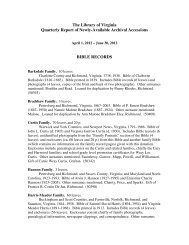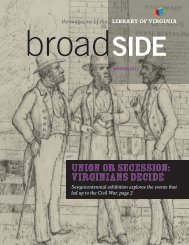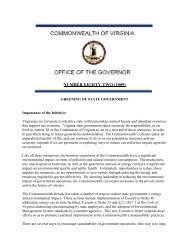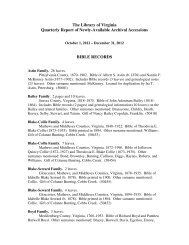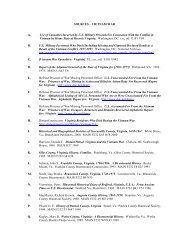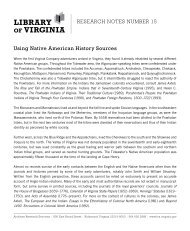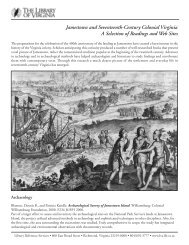the magazine of the - Library of Virginia
the magazine of the - Library of Virginia
the magazine of the - Library of Virginia
You also want an ePaper? Increase the reach of your titles
YUMPU automatically turns print PDFs into web optimized ePapers that Google loves.
800 E. Broad St. | Richmond, VA 23219<br />
www.lva.virginia.gov<br />
NON-PROFIT ORG.<br />
U.S. POSTAGE<br />
PAID<br />
RICHMOND, VA<br />
PERMIT NO. 1088<br />
Likely Signed by Lee<br />
Carte-de-visite photographs were popular Civil War–era keepsakes<br />
Tucked away within <strong>the</strong> numerous photographs <strong>of</strong> <strong>the</strong> Jones<br />
Family papers (Accession 44050) are two autographed<br />
carte-de-visite prints <strong>of</strong> Confederate general Robert E. Lee, taken<br />
in <strong>the</strong> studio <strong>of</strong> renowned photographer Mat<strong>the</strong>w Brady. The Lee<br />
signatures on <strong>the</strong> back may be au<strong>the</strong>ntic autographs as opposed<br />
to reproduced or duplicated ones. Though <strong>the</strong> two signatures are<br />
not identical, <strong>the</strong>y are very similar, indicating that <strong>the</strong> autographs<br />
came from <strong>the</strong> same hand. Perhaps a member <strong>of</strong> <strong>the</strong> Jones family—<br />
possibly John Wigginton Jones (1807–1894) or Edward Valentine<br />
Jones (1844–1923)—sent Lee <strong>the</strong>se cards and considered himself<br />
rewarded when <strong>the</strong>y were returned autographed.<br />
Introduced by French photographer André Adolphie Eugène<br />
Disdéri in 1854, <strong>the</strong> carte-de-visite photograph—a small albumen<br />
print mounted on a card (2 ½ inches by 4 inches)—was less expensive<br />
and easier to produce than <strong>the</strong> daguerreotype and <strong>the</strong> ambrotype.<br />
Images <strong>of</strong> celebrities were mass produced and sold to a clamoring<br />
public, and <strong>the</strong> carte-de-visite’s popularity exploded across Europe<br />
by 1859 and in <strong>the</strong> United States by 1860. Photographs <strong>of</strong> presidents<br />
and generals became big sellers. At <strong>the</strong> start <strong>of</strong> <strong>the</strong> Civil War, soldiers<br />
marching <strong>of</strong>f to battle gave <strong>the</strong> prints to <strong>the</strong>ir loved ones as keepsakes.<br />
The carte-de-visite’s reign ended in <strong>the</strong> 1870s when it was eclipsed by<br />
a larger print called a cabinet card.<br />
—Trenton Hizer, Senior Finding-Aids Archivist<br />
A version <strong>of</strong> this article originally appeared in <strong>the</strong> <strong>Library</strong>’s in-house<br />
online newsletter, The Delimiter.<br />
SPOTLIGHT<br />
CROWD-PLEASING PORTRAITS These carte-de-visite prints <strong>of</strong> Confederate general Robert E. Lee may include au<strong>the</strong>ntic autographs. In <strong>the</strong> 1860s, <strong>the</strong> public purchased <strong>the</strong>se prints<br />
<strong>of</strong> celebrities and <strong>of</strong>ten sent <strong>the</strong>m to those individuals in <strong>the</strong> hope that <strong>the</strong> photographs would be signed and returned.



